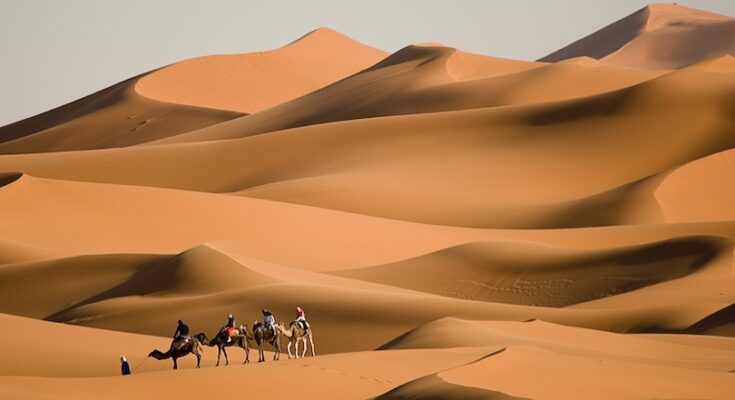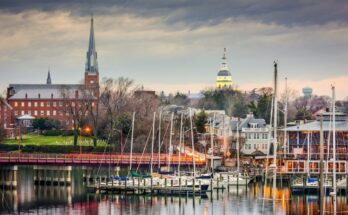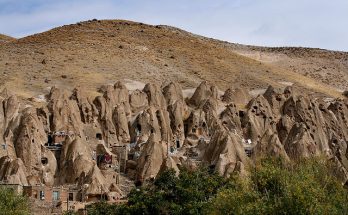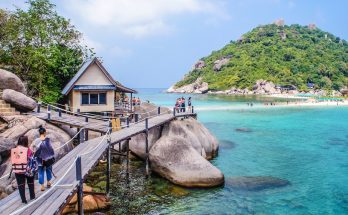It’s when the mint tea is poured that you can finally sit back and reflect on Morocco. When you do so, you’ll think about a country that packs an immense amount of diversity into a small space. Its sweeping deserts give way to the rising Atlas Mountains which fall towards historic cities lined with prismatic streets and alluring alleyways.
As the mint tea rolls into your soul, you’ll have flashbacks of time spent sampling the local cuisine in medieval medinas. You’ll look back on the Draa Valley and the markets of Marrakech. Images of Casablanca’s head-turning architecture will ring through your mind like a Bach symphony. Lastly, the Atlantic winds fill the sails of your memories guiding you along the vibrant coast.
Because of this, there’s no telling the experiences you can have at the top places to visit in Morocco if you leave yourself open. And that is the true blessing of Morocco.
Map of Morocco
16. Ourika Valley
In the shadow of the High Atlas, the Ourika Valley is a splendid change from the soaring heat. Just two hours from Marrakesh, it’s a popular change of scenery for those looking to escape the city’s bustling nature.
Ourika Valley is tranquil with the Ourika River cooling the air and nourishing the banks. From February to April, the valley is alive with cherry orchards in addition to the varied colors created by sprawling wildflowers.
After fueling up at the waterfront restaurants in Setti Fatma, it’s time to explore. Terraced hills carve into the foothills with hiking and horseback riding trails throughout. The Setti Fatma Waterfalls are a sightly oasis and a great place to swim. While the Berber villages found along the valley with friendly locals provide a wonderful glimpse into a rich way of life.
15. Agadir

Along Morocco’s southern coast, Agadir exemplifies modern Morocco. Wrecked by an earthquake in 1960, the colorful port town was reborn just four years later. Now, there are an assortment of lush parks and gardens set between the collection of modern hotels and Spanish Costa buildings. They’re all spread along a coast that boasts ivory sand.
Tourism is the heart of Agadir. Where trade and imperialism are on display elsewhere, the coastal city presents a chance to slow down and recharge. Local beaches spread for miles along the coast, with sun loungers in high demand as locals and visitors alike dance between the sea and the fresh-bought novel.
Beyond the beaches lies Paradise Valley, where mountain roads lead into twisting valleys encased in rock walls. The adventure-minded traveler will find hiking aplenty while emerald lakes lie just around the corner.
14. Casablanca

Between the imperial city of Marrakesh and the resort town of Agadir lies the Art déco mecca of Casablanca. Many will visit Morocco for the history or the beaches, which puts Casablanca in an awkward spot. But that’s all the more reason to visit.
Those who love to wander and admire will quickly fall in love with Casablanca. The colorful Art Déco buildings set the city apart from others in the country. The 20th century style and French influence have provided Casablanca with the vibrant Mers Sultan Square in addition to the Grande Poste.
These, however, lie in the shadow of the captivating Hassan II Mosque. Not just the largest in Morocco, it’s arguably the finest on earth. The facade is spellbinding, its interior equally so. Intricate wood carvings are complemented by the lovely tiling. Non-Muslim visitors can explore on a guided tour.
13. Ouzoud Falls

Near the village of Tanaghmeilt lies the totality of the Ouzoud Waterfalls. I say totality, as the 110-meter falls cascade down seven levels. The water is sourced from the High Atlas and combines to create the surging Ourika River.
For most, the falls lay at the end of a 2.5 hour journey from Marrakesh. Thankfully, such a trip is rewarded instantly with the falls’ best views. This is found at the top, with Ouzoud cascading into the abyss. From there, you can take roughly an hour’s journey down to the base with a guide.

Yep, that’ll mean you can’t avoid the classic gift shop stop. But you’ll find some traditional Berber cosmetics and spice sauces which come with complimentary bread. From the base, venture underneath the waterfalls via boat. Which, alongside soaking you, will provide travelers with the seismic roar of the falls. Afterwards, you can jump into the pool of water to cool off.
12. Rabat

Although it is often overlooked in favor of Agadir, Casablanca, and Marrakech, Morocco’s capital Rabat is well worth visiting. One of four imperial cities in the country, it is set on the northwest coastline and bordered by the Atlantic Ocean.
Home to peaceful, palm tree-lined boulevards and an atmospheric old medina, Rabat is a lovely place to wander around, with interesting historical sights and cultural landmarks dotted here and there. While its massive Royal Palace and beautiful Art Deco cathedral look a treat, the main attraction is its well-preserved kasbah.

This is not only home to a delightful old mosque, but also an idyllic Andalusian Garden and magnificent museum on the sprawling site’s history. Among its sturdy stone walls, you can find lots of exquisite architecture, as well as a beautiful blue and white painted neighborhood. From the kasbah, you can also enjoy astonishing views out over Rabat, its large public beach, and the ocean.
11. Sidi Ifni

Lying along Morocco’s southwest coastline, the small fishing town of Sidi Ifni is a lovely place to visit. It’s home to some beautiful beaches, great surf spots, and awe-inspiring rock formations. As it was only returned to Morocco in 1969 after decades of Spanish rule, the Berber town also has a fascinating history and culture for visitors to delve into.
As everything is painted blue and white, the city stands out delightfully against its desolate surroundings, with a few Art Deco buildings dotted around town. While Sidi Ifni has a very laidback vibe, lively cafes and restaurants can be found along its oceanfront and around its souk and old Spanish Town.
One of the main draws is its excellent beach, which is pounded by the waves of the Atlantic Ocean. Here you can enjoy surfing and kite surfing or simply sit back, relax and take in the magnificent scenery and dramatic coastal cliffs. When in Sidi Ifni, many people also take a trip to the nearby Legzira Beach to look at its spectacular 30-metre-high rock arch.
10. Meknes

Located near to the city of Fes in northern Morocco, Meknes is known as the “City of a Hundred Minarets” for its abundance of monuments, mosques, palaces and pavilions. Founded by a Berber tribe in the 9th century, Meknes rose to eminence during the 11th century as a fortified town. In the 1700s, the Sultan of Morocco Moulay Ismail made Meknes the country’s imperial capital and added to the city’s construction. It’s the city’s former prestige and glory that distinguishes it from other towns in Morocco. Few other places offer visitors such an intimate look at Morocco’s golden past. It is also the nearest city to the Roman ruins of Volubilis.
The Dar Jamai palace, located in a well-tended garden, includes a museum with exhibits of imperial clothing and jewels. The Sultan’s sumptuous palace, Dar El Makhzen, and mausoleum are worth a visit as well. Among the multiple monument gates in Meknes, the Bab Mansour is perhaps the most famous. The 11th-century gate cost its architect, El Mansour, his life. When the architect admitted that he felt he could have done better, the Sultan had him executed on the spot. Featuring elegant cobalt blue tile mosaics and marble columns confiscated from Roman ruins, the striking gate now bears the architect’s name.

Despite the wealth of historical sites throughout the city, Meknes has a laid-back atmosphere, primarily due to its large student population. Market places are animated with jugglers, musicians and fire-swallowers as well as with friendly easy-going merchants. Situated on the fertile plains below the Atlas Mountains, the city is supported by a vibrant agricultural industry. Whether feasting on locally produced olives and citrus, touring an 11th century subterranean prison or strolling through the site of an ancient palace, Meknes is filled with can’t-miss experiences to surprise and please every visitor.
9. Asilah

On Morocco’s Atlantic coast, the fortified village of Asilah is an amalgamation of epic sunsets, gorgeous beaches and ancient medinas. It’s a delectable combination that makes Asilah one to add to your Moroccan itinerary.
Now a popular seaside resort town, Asilah has a glorious history that dates back to when it was a trade center for the Phoenicians in 1500 BC. In the 19th and 20th centuries, pirates used it as a base of operations. Fortifications from these bygone eras remain, surrounding the restored medina. Asilah is located on Morocco’s north coast about 30 km (20 miles) from Tangier.
It’s a hot summer spot for Moroccans; travelers who want to avoid crowds had best visit in spring or fall. Whitewashed buildings complete the picturesque scene. It has a good selection of budget hotels and restaurants, and a growing art scene. About 2.5 km (1.5 miles) south of Asilah lies Paradise beach, a wonderful wide stretch of sand, popular with locals and tourists.
8. Draa Valley

From Agdz to Zagora, the Circuits Touristiques take you through the Draa Valley. Carved by waters stemming from the High Atlas, the valley’s oases are a pleasant reminder of the power of water.
Dotted along the valley are ancient Berber villages and kasbahs that fill the region with a sense of place, culture and heritage. The height of this is Kasbah des Caids. Within lies a maze of rooms, once home to the original chief.
Secret passageways meander between rooms and sun-soaked courtyards. Moorish, Jewish and Berber motifs are seen throughout. While the kasbah connects to the neighboring fortified village.
Complementing this is Amezrou, home to an extensive mud-brick Jewish quarter. A rammed-earth synagogue lies at the end of one of the many maze-like alleyways that feature artisans selling metal charms.
Beyond the villages lies remarkable landscapes like Erg Chigaga, the largest sand dune in the country. With mountains as bookends, you can venture into the endless dunes on camelback, camping at night until the stars.
7. Chefchaouen

Nestled among the Rif Mountains in northwest Morocco, Chefchaouen is one of the prettiest and most picturesque towns in the country. This is, in large part, because all the buildings in its old medina are painted a beautiful blue, and stand out delightfully against its dusty surroundings.
Known as the ‘Blue Pearl‘, the colorful old town’s winding narrow alleys are a delight to get lost in as lovely Moroccan and Andalusian architecture lies all around. These lead you past countless cozy cafes, traditional restaurants, and little hotels to its centuries-old kabash and lively souk, where you can buy local handicrafts and leatherwares.

While the medina is undoubtedly Chefchaouen’s highlight, the surrounding mountains and hills are also wonderful to explore; they are home to some amazing scenery, waterfalls, and viewpoints. In the nearby Talasemtane National Park, for instance, there are loads of scenic trails to hike along, taking you past cliffs and towering mountains with fabulous views wherever you look.
6. Tinghir & Todra Gorge

In the eastern Atlas Mountains, the Todra Gorge represent yet another example of Morocco’s astounding landscapes. Nearby Tinghir, a historic French garrison, surrounds a rock outcrop and features the ruins of Glaoui Palace.

As you explore the town, you’ll find ancient kasbahs, sightly gardens and narrow streets embellished with towering adobe dwellings. Surrounded by desert, the town is a human oasis where artisans fill the bazaars and alleyways creating an ethereal atmosphere.

Beyond the old-time village lies the dramatic rock faces and the picturesque canyon of Todra Gorge. The narrow canyon, sometimes only 10 meters wide, drops down a mesmerizing 300 meters. It’s a mecca for climbers, so too hikers who can explore the canyon. They’ll also find an assortment of Berber villages and castle ruins.
You can drive through the base of the gorge where you’ll have to step out as it narrows with the rock walls, soon enveloping everything you can see.
5. Essaouira

An 18th-century town on Morocco’s Atlantic coastline, Essaouira is one of the nation’s most popular beach destinations. White-washed homes sporting cobalt blue shutters provide a scenic backdrop for breezy seaside adventures, which include kitesurfing and windsurfing. The city’s medina features crafts made using centuries-old techniques, including thuya wood carving and cabinet making. The argan oil trade is well established here as well, and the women cooperatives responsible for processing the argan nuts are instantly recognizable from their long white robes.
Essaouira, formerly called Mogador, is a natural port. It’s been prized as such since the 1st century, when the protected bay provided anchorage for Romans trading for the purpura shells they used to make purple dye. Roman artifacts from the period are on display at the city’s Sidi Mohammed ben Abdallah Museum. Fortress walls originally circled the city’s borders, and many sections of the walls remain standing today. Built by the Sultan Sidi Mohammed ben Abdallah, the fortifications combine European military architecture with African aesthetics.

Today, the harbor is one of the major fishing locations in Morocco, and the city’s restaurants and seaside stalls offer an array of fresh seafood, from lobster dishes to grilled sardines.
In recent years, Essaouira has begun to gain a reputation as a cultural center too. Art galleries are appearing all over town, and each year, the city plays host to the Gnaoua Festival of World Music, a four-day event that includes multiple genres of music as well as the traditional Gnaoua African music. Whether riding a camel along the beach or touring the bird sanctuary at nearby Falcon Island, Essaouira offers a range of great travel experiences.
4. Fès

Founded in 789, Fes (or Fez) served as Morocco’s capital for hundreds of years. Today, the nation’s third-largest city is better known as Morocco’s handicraft center. Fes is the ideal destination for visitors who want to experience the heady and bustling ambiance of a Moroccan marketplace.
The government is taking great pains to return the historic old town, the medina Fes el Bali, to its original glory. With a population of about 150,000 inhabitants, the medina is the largest carfree urban area in the world by population. Traditional adobe homes and courtyards ornamented with mosaic tiles line a maze of narrow streets and alleys filled with souqs and shops.

Much of the fun of a visit to Fes comes through wandering through the old medina for up-close encounters with craftsmen making and selling their wares. Almost all of the traffic is pedestrian, although donkeys are sometimes used for transportation. The medina is where most of Morocco’s famous cobalt blue Moroccan ceramic tiles are made. Located in an 18th-century Moorish palace, the Dar Batha Museum houses a fine collection of ceramic tiles as well as other traditional Fes crafts, including woodcarving, copperware and sculpted plaster.
Fes is also home to the Karaouiyine mosque, which houses a medersa that is considered the oldest university in the world. With its splendid copper doors, minaret and stalactite-domed entrance chamber, the Bou Inania medersa is worth a visit as well. Like many cities in modern Morocco, Fes also has a Ville Nouvelle, or New City, that offers modern and comfortable accommodations for visitors to the ancient imperial capital.
3. Aït Benhaddou

The mud-brick fortified village of Aït Benhaddou has become the stuff of legend, thanks to a little thing called Hollywood. However, the UNESCO World Heritage village remains remarkably as it was in the 11th century. Frozen in time, Aït Benhaddou is a look into the founding years of the trade route between Marrakech and the Sahara.
The traditional Berber village sits between the celebrated city at the snow-capped Atlas Mountains. Along the journey lies open arid lands and dried river beds that flow into foothills. A rise in elevation brings a change in flora.

That’s when you’ll see the buildings of Aït Benhaddou, whose mud-brick red collides with hints of dense green. Beyond the geometric walls and crenelated towers lies a handful of families, continuing the ksar’s rich heritage. You’ll also find Ouallywood, and Atlas Film Studios where parts of Gladiator and Game of Thrones were filmed.
2. Merzouga

Set in a secluded spot not far from the Algerian border, the small village of Merzouga now makes for a popular base from which to explore the delights of the Sahara Desert. Towering over it are the enormous dunes of Erg Chebbi, which in some places reach over 300 meters in height.
It is these colossal sandscapes that most people come for, with hiking, quad biking, and camel safaris all popular ways to explore the dunes. Many visitors also camp in the desert overnight so that they can watch the stunning sunrises and sunsets that paint the dunes a myriad of beautiful colors.
Once merely a short stop and transit point for Arab and Berber merchants on their way to Timbuktu, Merzouga now has an increasing number of hotels for visitors to choose from. These cater to all budgets, with all of them offering excursions to the sights and sands of the desert all around you.
1. Marrakesh

Formerly one of the country’s imperial cities, Marrakesh is sometimes referred to as the Red City because of its sandstone buildings. Marrakesh was founded in the 11th century by the Almoravides, a Berber dynasty who turned the city into an important center of commerce, religion, philosophy and culture. Under Almoravide rule, red sandstone walls, lavish palaces and Koranic schools were built of which much can still be seen today.
During the 1960s, Marrakesh was known as a “hippie mecca,” attracting famous celebrities such as The Beatles, Yves Saint Laurent and the Rolling Stones. Comprised of beautiful old architecture and courtyards of orange, palm, apricot and olive trees, Marrakesh today is still one of Africa’s most popular tourist destinations.

At the heart of the Marrakesh is the Medina, a labyrinth of old walls and narrow passageways packed with historic sites, museums, enticing food stalls and colorful souks, or markets. The focal point of the Medina is Djemaa El-Fna, the main square, buzzing with snake charmers, musicians, acrobats, storytellers, magicians and stalls selling the likes of carpets, leather, pottery, hookahs and spices. Other must-see sites in Marrakesh are the 12th century Koutoubia Mosque, the Saadian Tombs, Bahia Palace and the Jardin Majorelle, a botanical garden that blends art deco and Moorish features.
Morocco Travel Video




